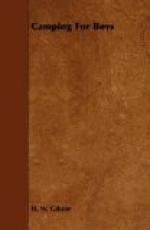Archery
Richard the Lion-hearted, of England, said the five essential points of archery—standing, nocking[1], drawing, holding, and loosing—“honestly represented all the principles of life.”
Archery develops the muscles in all-round fashion, particularly those of the shoulder, arm and wrist.
[Transcriber’s Footnote 1: A nock is the groove at either end of a bow for holding the bowstring or the notch in the end of an arrow that fits on the bowstring.]
The Target
A target can be made of a burlap sack, or oil cloth, about five feet square. Stuff this with hay or straw. It may be flattened by a few quilting stitches put right through with a long packing needle. On this the target is painted. In scoring, the centre is 9, the next circle 7, the next 5, the next 3 and the last circle 1. The shortest match range for the target is forty yards.
The Bow
The bow may be made from any of the following woods—mulberry, sassafras, southern cedar, black locust, black walnut, apple, slippery elm or hickory. In making a bow, select wood with straight grain. The length of the bow should be about the height of the boy using it, or if the boy is between ten and fifteen years of age, his bow should not be less than four feet in length and not more than five feet. When buying a bow get one of lancewood backed with hickory.
Making A Bow
The making of the bow and arrow is described by A. Neeley Hall, as follows: “Cut your piece of wood five feet long, and, after placing it in a bench vise to hold it in position, shape it down with a drawknife or plane until it is one inch wide by one-half inch thick at the handle, and three quarters inch wide by one-quarter inch thick at the ends. The bow can be made round or flat on the face toward the archer. Cut a notch in the bow two inches from each end, as shown in the illustration, from which to attach the bow-string. A cord with as little elasticity as possible should be used for this. A good string can be purchased for twenty-five cents.
[Illustration: Notch for Bowstrings; Length of Bow 5 feet. Wire nail with head cut off (arrow head) Old Canvas Stuffed (target); Loop (in bowstring); slip knot.]
With a home-made bow-string, a loop should be made in one end and bound with thread, as shown in illustration, p. 227. Slip the loop over the upper notch, bend the bow until the center of the string is about five inches away from the handle, and attach the loose end to the lower notch by means of a slip-knot similar to that shown in the drawing. The bow should then be sandpapered until smooth, and thoroughly oiled with linseed oil. Glue a piece of velvet about three inches wide around the center for a handle.”
Making Arrows




